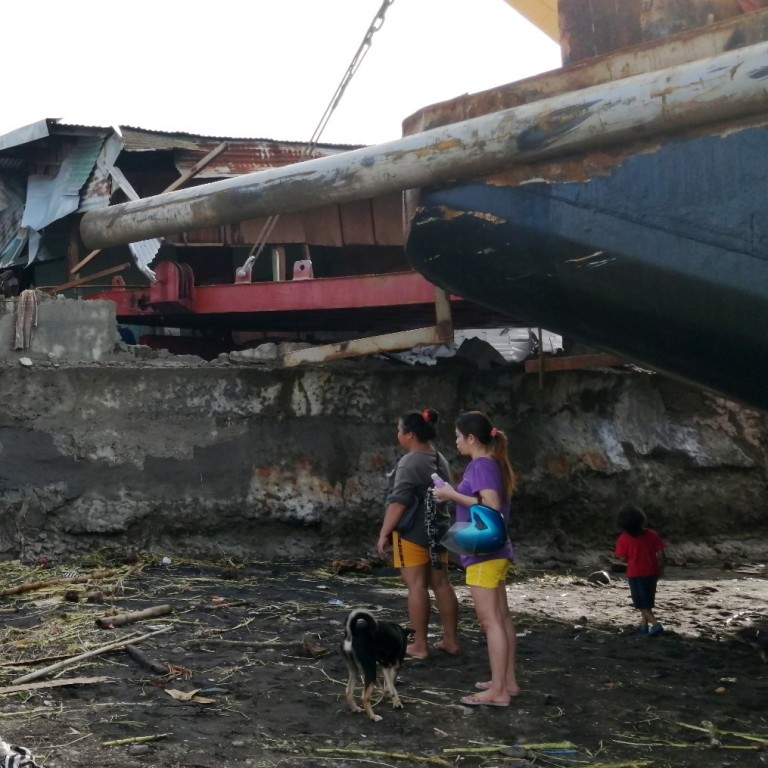
At least 28 dead after Typhoon Phanfone lashes central Philippines on Christmas Day
- Typhoon Phanfone, with winds of 195 kilometres an hour, tore roofs off houses and toppled electricity pylons as it cut across the Philippines
- A full assessment of the damage has not been completed, but disaster agency officials said at least 28 people had been confirmed killed in the Visayas
A strong typhoon that barrelled through central Philippines left at least 28 people dead and forced thousands to flee their homes, devastating Christmas celebrations in the predominantly Catholic country.
Most of the deaths reported by officials were due to drowning, falling trees and accidental electrocution.
A father, his three children and another relative were among those missing in hard-hit Iloilo province after a swollen river inundated their shanty, officials said.
One disaster response officer described the battered coastal town of Batad in Iloilo province as a “ghost town” on Christmas Day.
“You can’t see anybody because there was a total blackout, you can’t hear anything. The town looked like a ghost town,” Cindy Ferrer of the regional Office of the Civil Defence said by phone.
Phanfone also hit Boracay, Coron and other holiday destinations that are famed for their white-sand beaches and popular with foreign tourists.
Mobile phone and internet access on Boracay was cut during the storm and the networks remained down on Thursday, making assessment of the damage there difficult.
“Still, communication lines are down. Electricity is still down,” said Jonathan Pablito, police chief of Malay town in Alkan province, which is on an island neighbouring Boracay.
Pablito said ferry services between Boracay and Aklan – the main way to travel to and from the holiday island – were still not operating on Thursday, even though the storm had passed.
“We have no news from coastguard if ships were allowed to sail. Since the 24th … all those going to the island and coming from the island weren’t able to cross,” Pablito said.

The airport at Kalibo town in Aklan, which services Boracay, was badly damaged, according to a Korean tourist who was stranded there.
“Roads remain blocked, but some efforts have been made to clear away the damage. It’s pretty bad,” Jung Byung-joon said via Instagram messenger.
“Everything within 100 metres of the airport looks broken. There are a lot of frustrated people at the airport as flights have been cancelled,” Jung said. “Taxis are still running but it’s windy and still raining so no one wants to leave the airport, including me.”

Another Korean tourist stuck at the damaged airport said she had been unable to make contact with her friend on Borocay on Thursday.
“I tried to call my friend in Boracay today and wasn’t able to get through. Maybe something isn’t working,” said Dahae Gong via Instagram. “I don’t know when I will be able to go home.”
The storm weakened slightly on Thursday as it blew into the South China Sea with sustained winds of 120 kilometers (74 miles) per hour and gusts of 150 kph (93 mph) after lashing island after island with fierce winds and pounding rain on Christmas Day, the weather agency said.
Typhoon Kammuri flooding forces tens of thousands from their homes in Philippines
The typhoon slammed into Eastern Samar province on Christmas Eve and then barrelled across the archipelago’s central region on Christmas, slamming into seven coastal towns and island provinces without losing power, government forecasters said.
Provincial officials, army troops, police and volunteers spent Christmas away from home to tend to thousands of displaced residents in town gymnasiums and schools turned into emergency shelters.
More than 25,000 people were stranded in sea ports across the central region and outlying provinces after the coast guard prohibited ferries and cargo ships from venturing into dangerously choppy waters. Dozens of domestic flights to and from the region were cancelled.
“It’s like the younger sibling of Haiyan. It’s less destructive, but it followed a similar path,” said Cindy Ferrer, an information officer at the Western Visayas region’s disaster bureau.
The Philippines is the first major land mass facing the Pacific typhoon belt, and is hit by an average of about 20 major storms a year.
Many of the storms are deadly, and they typically wipe out harvests, homes and infrastructure, keeping millions of people perennially poor.
The Southeast Asian nation is also located in the Pacific “Ring of Fire”, where earthquakes and volcanic eruptions often occur, making the country of more than 100 million people one of the world’s most disaster prone.

.png?itok=arIb17P0)
